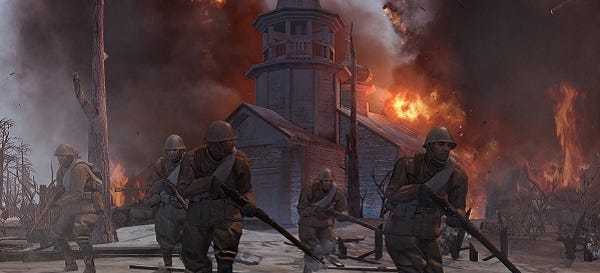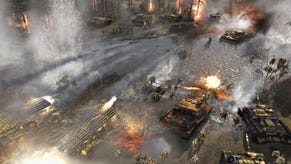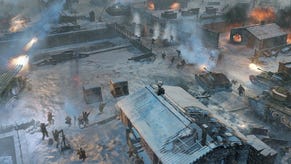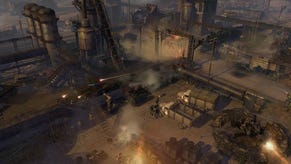First Look: Company Of Heroes 2
Tragedies, not statistics
Looking back, I should have known it would be the Eastern Front. The entire world may well know by now that Company of Heroes 2 is in development at Relic, due for release sometime in 2013, and if they’ve paid any attention whatsoever they’ll also be aware that it’s set on the Eastern Front with a campaign beginning in 1941. What they don’t know is that we are among the few outside the studio who’ve already seen the game in action and right up until we entered the briefing room, we had no idea when or where it was set.
It’s the night before the reveal. I know I’m in Vancouver to see Company of Heroes 2 but that’s just about all I know. Outside there’s a frenzied roar building, not yet audible but it’s in the city’s throat, caught up in the webbed haze of the unseasonal warmth, ready to release through the scream of an airhorn, the gathering of a crowd.
Most people here aren’t thinking about Company of Heroes, they’re thinking about the hockey play-offs. If you own a bar or restaurant without a TV, tomorrow’s going to be a bad day for business. Everybody is going to be watching and I feel like I must be the only insomniac in town who’s not got pucks on the mind. Instead, I’m preparing lists of questions about the Pacific and the Soviets, along with scrawled backups that I hope not to use: ‘why go to Vietnam?’ and ‘what fresh aspect of modern warfare will this company of heroes be exploring?’
Now that everybody knows it was the Eastern Front I saw the next day, I feel as if it should never have been in doubt. It’s what I’d been hoping for and what I saw didn’t disappoint. In action, Company of Heroes 2 is a work of brutal beauty but as I haven’t actually played it yet, it’s the visual upgrades that I can comment on with most authority.
The original game still looks the part and the sequel has the same viewpoint and scale but with a host of additions. Here’s some of what I scribbled down before I saw the footage, as we were told what we were about to see: “on a par with Battlefield 3”, “HDR lighting”, “DX11”, “all new water renderer”. Here’s what I wrote while I was watching somebody play through a mission: “individual flakes settling on an infantryman’s sleeve”, “a tank desperately grips splintering ice”, “flames chew up the only shelter for miles around, the smoke like a living thing, the men who hid inside spilling out like dolls from an overturned playhouse.”
Admittedly, I didn’t quite write those things at the time but I did write approximations of them. Sort of. Flicking through my far more mundane notes taken at the event, one word crops up again and again: ‘details’. Not the individual screws on a gun or a vehicle that show the months of research and field trips that have gone into the game – that’s all there too but it’s not what my eye is drawn to - I’m fascinated by the detail of how each man dies, writhing with a bullet in his gut, creating warped snow angels with scarlet robes; the detail of how bad becomes worse, the weather and the orders from above as lethal as the burst of a mortar.
This is a game about the few, not the many, but in a theatre where up to eleven million Soviet soldiers are thought to have been killed, the bigger picture looms larger than ever before. “The Eastern Front is the epicentre of combat”, went the line, as well as the admission that Company of Heroes, including its expansions, has only touched on a minute portion of WWII, “four months of six years”. The complaint that we’ve seen this conflict too many times is pre-empted and cut down; nobody has seen these stories before, not only because we’re taking the blasted and frozen road less travelled, but because the aim is to let every player tell their own story.
A change in place and participant isn’t enough to achieve all of Relic’s aims, and all the graphical detail in the world doesn’t make a picture’s thousand words worth writing unless there’s meaning in it all. Part of that meaning comes from the focus on the stories of brave men in terrible situations. The mission shown incorporated horrific application of Stalin’s Order 227, the final desperate acceptance that the Soviet resistance had been pushed to its limits. No retreat was permitted, not even one step back, and for a time this was enforced by “blocking detachments” who were commanded to fire on their compatriots should they retreat or panic.
Ideologies aren’t anywhere to be seen in the waste and ruin, although Relic will be addressing the decisions of politicians and generals as well as the tactical choices of the men down in the thick of it. The campaign follows the Red Army as they push the Germans back and move from the brink of defeat, bogged down and wounded in the winter wilderness, to victory and the streets of Berlin. While individual missions follow history’s forgotten men, heroes by their actions in the horror of combat rather than due to their beliefs or the uniform they wear, the campaign itself will be told through the voice of a Soviet war correspondent exposing the truth of Communist ideology.
If Relic succeed in this, allowing the player to have some control over the individual stories of the men under his/her command while providing context of a different sort to the cold and the carnage with the addition of a journalistic and political view, the game could offer something new in narrative terms to go with the fresh setting and technology. Speaking to the team and watching historical footage with them, both propaganda and battlefield, it’s clear that they’ve immersed themselves in the horror, the hardware and the detail to a sometimes obsessive degree.
To my mind, the attempt to present both the individual and the ideological is new to the series, although Relic are keen to communicate that they still wish to represent heroism on every side. It’s the Red Army who take centre stage, aggrieved and aggressive, a hammer striking back at a powerful but withering advance. “Quantity has a quality all its own” has the air of aphorism but Stalin’s armies are built around it, less professional and tactically astute than the Germans, but more numerous and with their backs not against a wall but against the bayonet of a brother in arms.
Given that the focus is still on the few rather than the many, one of Relic’s challenges will be convincing of the scale of conflict and loss with the camera zoomed in so tight. There are sounds of distant slaughter and the machinery of warfare, and reinforcements arrive from offscreen, not as if from a drop pod or the training ground, but almost as if stumbling from a neigbouring skirmish, their nerves frazzled, their uniforms wet and stained.
So, yes, it looks the part, it has the heritage and Relic are as well versed in the history as could be hoped, as well as conveying a sense that they wish to respect those who lost their lives. Being given what amounted to a lecture before seeing the game, covering the cruelties inflicted, the starvation and the desperate lack of shelter that the soldiers were faced with is a far cry from the slow motion kill cams that are often in place to convince of the ‘grim gritty grimness of war’. That the Brits in the room introduced members of Relic to Blackadder Goes Forth afterwards is something I shall always remember fondly.
It’s how the soldiers act, and react, that I’m primarily interested in though. Although there was a degree of scripting in the demo, particularly to draw attention to the ‘no surrender, no retreat’ policy, the claim that the same AI that powers the skirmish mode is now present throughout the campaign seemed accurate. What this should mean is that rather than knowing their way around a map because they are part of that map’s specific story, enemies react to the player’s tactics as and when they change. Attempt to flank and machine guns may be wheeled into place to block that flank. Soldiers react to smoke, not simply by freezing and becoming prone, but by searching for cover and a new angle from which to attack.
A great deal of the tactical advancement is thanks to what Relic call the True Sight system. While the original Company of Heroes used traditional line of sight, for the sequel not only does the world appear in three dimensions, every entity’s vision works across the space as it is represented. Anything from a branch to the smoke from a burning farmhouse can block sight, and as walls crumble, tanks grind to a screaming halt and trees splinter and collapse, every damaged element affects each individual’s view of the battlefield exactly as it should. You see what they see.
Fortunately, soldiers aren’t stupid. If their cover is destroyed, they’ll go prone and look for somewhere else to hide, and if a tree falls, blocking their view of a previously exposed enemy, they’ll shuffle into position and open fire. But because line of sight is no longer based around a radius of awareness, exploration and recon is hugely important. It’s possible to be within metres of a silent enemy, waiting in ambush, without being aware, unless you’re smart enough to have your company split into several groups, each with eyes trained on the blind spots of the others.
So while there is still scripting there will be far less of it. Relic admit that they had to ‘fudge’ ambushes in the original game, permitting the AI to know what it shouldn’t and couldn’t know in order to trigger dramatic events. Now, it’s capable of doing that within the rules of the engine and that means it can be more unpredictable and, dare I say, more human than ever. That’s us humans, you see, defined by our ability to be ballerinas in one moment and then to trip over our own shoelaces in the next.
What about vehicles? There will be loads of them, more of which in upcoming interviews. If you kill the crew, you’ll be able to commandeer enemy machines for your own use, which could be another method of making each battle more changeable. I saw tanks, including the Soviet T-34, which almost bounces through the snow, its suspension distinctly untanklike to my untrained eyes, although apparently that’s the way it was. That’s the thing; I think everything in the game is probably fairly close to the way it was, from the sound of each gun being fired to the sound of each shell casing hitting various types of surface, everything seems to be covered.
The bleakness and brutality are the main memories. If this is to be a game of details, of tragedies rather than statistics, then when the smoke settles in the air and the snow settles on the corpses, every battle’s aftermath should tell a story. The shattered barn where they attempted to hide; the field that they should never have risked crossing, pockmarked with craters now; the felled metal beast that became a coffin for its crew and cover to the men who found its weakness and brought it low.
It’s the research that’s gone into the game, the history that drives it and what the franchise means to Relic that we’ll explore in the first of two interviews. After that, some discussion of multiplayer and the philosophy of authenticity over balance, and, who knows, maybe even some perhaps surprising comments about another game that I definitely didn’t berate them for not making a sequel to.




















